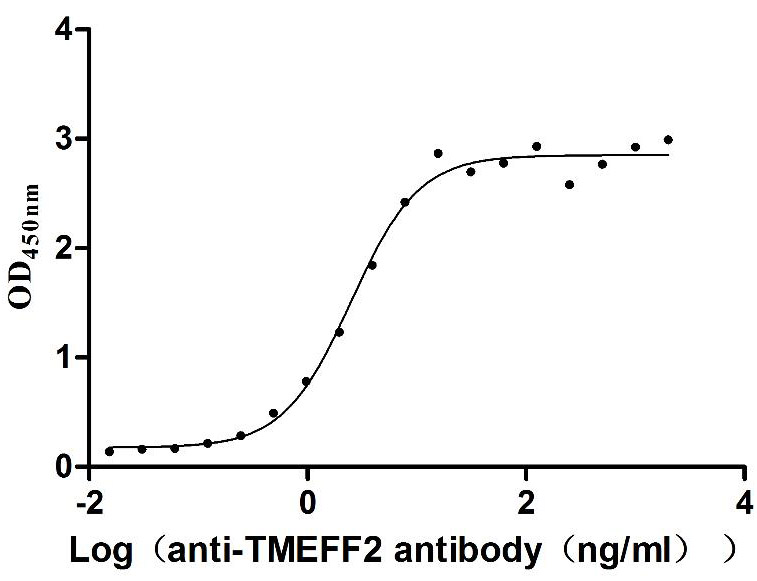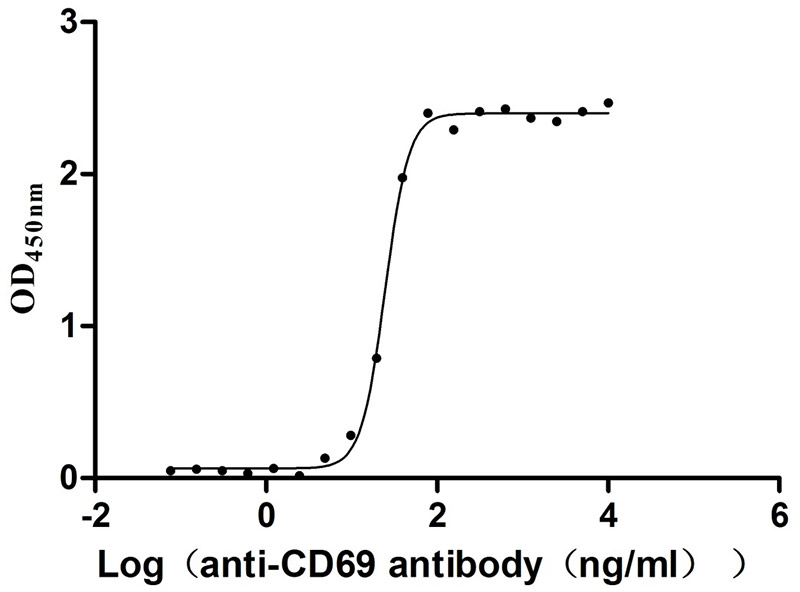Recombinant Mouse Metastasis-suppressor KiSS-1 (Kiss1)
-
中文名称:小鼠Kiss1重组蛋白
-
货号:CSB-YP765002MO
-
规格:
-
来源:Yeast
-
其他:
-
中文名称:小鼠Kiss1重组蛋白
-
货号:CSB-EP765002MO
-
规格:
-
来源:E.coli
-
其他:
-
中文名称:小鼠Kiss1重组蛋白
-
货号:CSB-EP765002MO-B
-
规格:
-
来源:E.coli
-
共轭:Avi-tag Biotinylated
E. coli biotin ligase (BirA) is highly specific in covalently attaching biotin to the 15 amino acid AviTag peptide. This recombinant protein was biotinylated in vivo by AviTag-BirA technology, which method is BriA catalyzes amide linkage between the biotin and the specific lysine of the AviTag.
-
其他:
-
中文名称:小鼠Kiss1重组蛋白
-
货号:CSB-BP765002MO
-
规格:
-
来源:Baculovirus
-
其他:
-
中文名称:小鼠Kiss1重组蛋白
-
货号:CSB-MP765002MO
-
规格:
-
来源:Mammalian cell
-
其他:
产品详情
-
纯度:>85% (SDS-PAGE)
-
基因名:Kiss1
-
Uniprot No.:
-
别名:Kiss1Metastasis-suppressor KiSS-1; Kisspeptin-1) [Cleaved into: Metastin; Kisspeptin-52); Kisspeptin-10; Metastin45-54)]
-
种属:Mus musculus (Mouse)
-
蛋白长度:Full Length of Mature Protein
-
表达区域:20-130
-
氨基酸序列E PLAKVAPLVK PGSTGQQSGP QELVNAWEKE SRYAESKPGS AGLRARRSSP CPPVEGPAGR QRPLCASRSR LIPAPRGAVL VQREKDLSTY NWNSFGLRYG RRQAARAARG
-
蛋白标签:Tag type will be determined during the manufacturing process.
The tag type will be determined during production process. If you have specified tag type, please tell us and we will develop the specified tag preferentially. -
产品提供形式:Lyophilized powder
Note: We will preferentially ship the format that we have in stock, however, if you have any special requirement for the format, please remark your requirement when placing the order, we will prepare according to your demand. -
复溶:We recommend that this vial be briefly centrifuged prior to opening to bring the contents to the bottom. Please reconstitute protein in deionized sterile water to a concentration of 0.1-1.0 mg/mL.We recommend to add 5-50% of glycerol (final concentration) and aliquot for long-term storage at -20℃/-80℃. Our default final concentration of glycerol is 50%. Customers could use it as reference.
-
储存条件:Store at -20°C/-80°C upon receipt, aliquoting is necessary for mutiple use. Avoid repeated freeze-thaw cycles.
-
保质期:The shelf life is related to many factors, storage state, buffer ingredients, storage temperature and the stability of the protein itself.
Generally, the shelf life of liquid form is 6 months at -20°C/-80°C. The shelf life of lyophilized form is 12 months at -20°C/-80°C. -
货期:Delivery time may differ from different purchasing way or location, please kindly consult your local distributors for specific delivery time.Note: All of our proteins are default shipped with normal blue ice packs, if you request to ship with dry ice, please communicate with us in advance and extra fees will be charged.
-
注意事项:Repeated freezing and thawing is not recommended. Store working aliquots at 4°C for up to one week.
-
Datasheet :Please contact us to get it.
靶点详情
-
功能:Metastasis suppressor protein. May regulate events downstream of cell-matrix adhesion, perhaps involving cytoskeletal reorganization. Generates a C-terminally amidated peptide, metastin which functions as the endogenous ligand of the G-protein coupled receptor GPR54. Activation of the receptor inhibits cell proliferation and cell migration, key characteristics of tumor metastasis. The receptor is also essential for normal gonadotropin-released hormone physiology and for puberty. The hypothalamic KiSS1/GPR54 system is a pivotal factor in central regulation of the gonadotropic axis at puberty and in adulthood. Intracerebroventricular administration induces an increase in serum LH and FSH levels in prepubertal male and female as well as in adult animals.
-
基因功能参考文献:
- This study showed for the developmental profile of kisspeptin in the mouse pituitary. PMID: 27871073
- The findings are consistent with the idea that, during metabolic deficiency, AgRP signaling contributes to infertility by inhibiting Kiss1 neurons. PMID: 28196880
- Study used Cre-lox technology to selectively ablate tyrosine hydroxylase (TH) from Kiss1 cells. Surprisingly, despite a practically complete knock-out of TH from Kiss1 cells, study found that all aspects of puberty, reproductive hormone secretion, and fertility were normal in Kiss THKOs. This suggests that dopamine synthesized in Kiss1 cells is not required for normal puberty and reproduction. PMID: 28660243
- Kisspeptin governs both mate preference and sexual motivation in female mice, indicating that sexual behavior and ovulation are coordinated by the same neuropeptide. PMID: 29374161
- POMC and AgRP neurons receive direct steroid- and frequency-dependent glutamatergic synaptic input from Kiss1(ARC) neurons in male mice PMID: 27093227
- mice carrying Stat5a/b inactivation specifically in kisspeptin cells were generated. These mutants exhibited an early onset of estrous cyclicity, indicating that STAT5 transcription factors exert an inhibitory effect on the timing of puberty. PMID: 28344041
- steroidal environment and energy state negatively regulate kisspeptin (Kiss1), neurokinin B (Tac2), and dynorphin (Pdyn) gene expression. PMID: 27507595
- loss of PGR impairs kisspeptin secretory machinery and therefore that PGR plays a critical role in regulating kisspeptin secretion. PMID: 27441639
- expression in anteroventral periventricular nucleus cells increases with estradiol exposure PMID: 27409645
- Neurons in the hypothalamus produce Kiss1 and can synchronize their activity and activate GnRH neurons thus coordinating reproduction and fertility. PMID: 27558594
- Our data indicate the absence of the circadian input to Kiss1 in pregnancy, despite high gestational estradiol levels and normal clock gene expression, and may suggest a disruption of a kisspeptin-specific diurnal rhythm that operates in the nonpregnant state. PMID: 27068699
- medial amygdala expression increases around puberty, coincident with developmental increases in sex steroids PMID: 27564649
- In the anteroventral periventricular, ERalpha is required but not ERbeta or GPR30, vs the arcuate nucleus Kiss-expressing cell lines that require GPR30, and either ERalpha and/or ERbeta. PMID: 26726951
- Data show that estradiol has no effect on kisspeptin (Kiss1) mRNA expression in prepubertal Kiss1 cell-specific estrogen receptoralpha knockout (KERalphaKO) mice. PMID: 26824364
- The results suggest that the 5'-upstream region of Kiss1 locus functions as an enhancer for the arcuate nucleus Kiss1 gene expression in mice. PMID: 25486239
- progesterone signaling specifically in kisspeptin cells essential for the positive feedback induction of normal LH surges, ovulation, and normal fertility in females PMID: 26076042
- neural circuits between kisspeptin and GnRH neurons in the male mouse arcuate nucleus of the hypothalamus established before birth PMID: 26172029
- the mechanism by which kisspeptin is suppressed during lactation involves a number of factors, including chronically elevated levels of prolactin PMID: 25207795
- findings suggest that the suppressive signalling of RFRP-3 on Gonadotrophin releasing hormone transcription may dominate over kisspeptin induction in the mHypoA-GnRH/GFP Gonadotrophin releasing hormone neuronal cell model. PMID: 25283492
- This study show that estrogen is found to permit circadian AVP signaling at preoptic kisspeptin neurons rather than dynamically modulate its activity throughout the estrous cycle. PMID: 25926463
- kisspeptin can act partly through neuropeptide FF receptors to modulate neuronal activity of the arcuate nucleus independent of GPR54 in the mouse brain. PMID: 25756309
- These data document kisspeptin expression in mouse Leydig cells, its secretion into peripheral serum, and its regulation by changes in reproductive neuroendocrine function. PMID: 25635620
- This study demonistrated that Fertility-regulating Kiss1 neurons arise from hypothalamic POMC-expressing progenitors. PMID: 25855171
- These experiments clearly demonstrate that ERalpha in kisspeptin neurons is required for the positive, but not negative feedback actions of E2 on GnRH/LH secretion in adult female mice. PMID: 25545386
- KISS-54 influences Isl-1 expression and insulin secretion through the protein kinase C-ERK1/2 pathway. PMID: 24956377
- Our data show that PI3K signaling is important for the regulation of hypothalamic kisspeptin expression PMID: 25269483
- These observations demonstrate the necessity of perinatal GnRH signaling for driving brain sexual differentiation and indicate that kisspeptin inputs to GnRH neurons are essential for this process to occur. PMID: 25392497
- No significant differences in puberty onset, oestrous cyclicity or reproductive competency were observed in the female or male kiss1 knockout mice PMID: 24824308
- Data suggest that the kisspeptin-1 could regulate mammalian fertilization and reproduction. PMID: 24567427
- In diabetic mice, liver Kiss1 knockdown improves glucose-stimulated insulin secretion and glycemia. PMID: 24703698
- plays a central role in relaying the positive feedback effects of estradiol on GnRH neurons. PMID: 24112790
- Loss of Kiss1 expression specifically disrupts embryo attachment to the uterus. PMID: 24877624
- Sex differences in reproductive genes Kiss1, Gnrh1, and Gad1 are critically disturbed in GABAB1-deficient mice, probably altering the organization and development of neural circuits governing the reproductive axis. PMID: 24080944
- Data from transgenic mice suggest that higher levels of circulating estradiol modify colocalization of Kiss1 and ERalpha (estrogen receptor alpha) and proportion of Kiss1 neurons acutely responding to ghrelin stimulation. PMID: 24473434
- BMP-4 suppresses kisspeptin-induced GnRH expression by reducing ERK signaling activity. PMID: 23880664
- GABAB signaling may normally directly or indirectly inhibit Kiss1 expression, particularly in the bed nucleus of the stria terminalis and medial amygdala PMID: 24424047
- kisspeptin induces LHbeta and FSHbeta gene expression, and this induction is protein kinase C dependent and mediated by the immediate early genes, early growth response factor 1 and cFos, respectively. PMID: 23770611
- results suggest that RFRP-3 may modulate a small proportion of kisspeptin-producing neurones in mice, particularly in the arcuate nucleus, whereas kisspeptin neurones are unlikely to have any direct reciprocal actions on RFRP-3 neurones PMID: 23927071
- a selective loss of kisspeptin inputs from the rostral periventricular area of the third ventricle to GnRH neurons during lactation is the likely mechanism causing lactational anovulation in the mouse PMID: 24169550
- The translation of Kiss1 mRNA and/or the degradation/transport/release of kisspeptins are different in mice and rats. PMID: 23651990
- These data indicate regulation of GnRH release by NK3R agonists is site specific and suggest that kisspeptin is not a required mediator between NK3R activation and GnRH secretion in the median eminence. PMID: 23928373
- Data suggest sex development can occur without GnRH (gonadotropin releasing hormone), but GnRH/down-stream estradiol signaling are needed before juvenile development for complete feminization/maximal Kiss1 expression in adult female thalamic nuclei. PMID: 23825121
- Data indicate that the 2 kisspeptin neuronal populations (anteroventral periventricular nucleus/periventricular nucleus continuum [AVPv/PeN] and arcuate nucleus [ARC]) seem to be differentially organized and activated by estradiol (E(2)). PMID: 23744640
- Data show that dynorphin and neurokinin B have opposing actions on the electrical activity of kisspeptin neurons. PMID: 23744641
- Data suggest that activation of neurokinin 3 and kappa-opioid receptors (NK3R and KOR) excites and inhibits kisspeptin, neurokinin B (NKB), and dynorphin (KNDy neurons). PMID: 23744642
- Data suggest that males require only 5% of normal Kiss1 expression to be reproductively competent, whereas females require higher levels for reproductive success. PMID: 23736293
- Liver receptor homolog-1 (LRH-1), a member of the nuclear receptor superfamily, is expressed in kisspeptin neurons in the arcuate nucleus but not in the anteroventral periventricular in female mice. PMID: 23504956
- kisspeptin neurons are not the direct target of leptin in the onset of puberty. Leptin signaling in kisspeptin neurons arises only after completion of sexual maturation. PMID: 23505551
- kisspeptin neurons may contribute to the generation of the preovulatory gonadotropin-releasing hormone surge PMID: 23804103
- kisspeptin neurons are capable of burst firing, and their activity is modulated by sex steroids and other regulatory factors. PMID: 23550014
显示更多
收起更多
-
亚细胞定位:Secreted.
-
蛋白家族:KISS1 family
-
组织特异性:Weak in all tissue types with highest levels in lung and 15- 17-day embryos. Expressed in areas of the hypothalamus implicated in the neuroendocrine regulation of gonadotropin secretion, including the anteroventral periventricular nucleus, the periventric
-
数据库链接:
Most popular with customers
-
Recombinant Severe acute respiratory syndrome coronavirus Spike glycoprotein (S), partial (Active)
Express system: Mammalian cell
Species: Human SARS coronavirus (SARS-CoV) (Severe acute respiratory syndrome coronavirus)
-
Recombinant Human Poliovirus receptor (PVR) (I340M), partial (Active)
Express system: Mammalian cell
Species: Homo sapiens (Human)
-
Recombinant Human B-lymphocyte antigen CD20 (MS4A1)-VLPs (Active)
Express system: Mammalian cell
Species: Homo sapiens (Human)
-
Recombinant Human Claudin-4 (CLDN4)-VLPs (Active)
Express system: Mammalian cell
Species: Homo sapiens (Human)
-
Recombinant Macaca fascicularis Trophoblast glycoprotein (TPBG), partial (Active)
Express system: Mammalian cell
Species: Macaca fascicularis (Crab-eating macaque) (Cynomolgus monkey)
-
Recombinant Human Claudin-6 (CLDN6)-VLPs, Fluorescent (Active)
Express system: Mammalian cell
Species: Homo sapiens (Human)
-
Recombinant Human Tomoregulin-2 (TMEFF2), partial (Active)
Express system: Mammalian cell
Species: Homo sapiens (Human)
-
Recombinant Human Early activation antigen CD69 (CD69), partial (Active)
Express system: Mammalian cell
Species: Homo sapiens (Human)


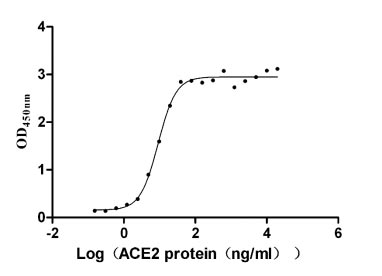
-AC1.jpg)
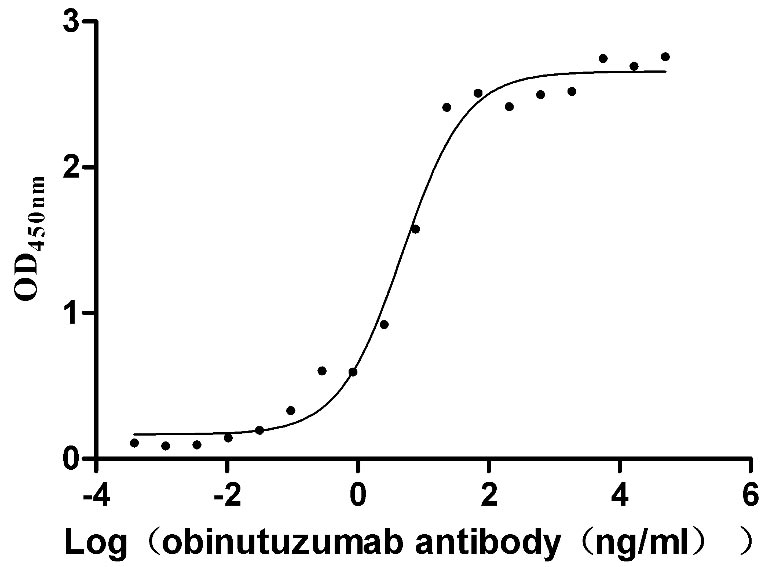
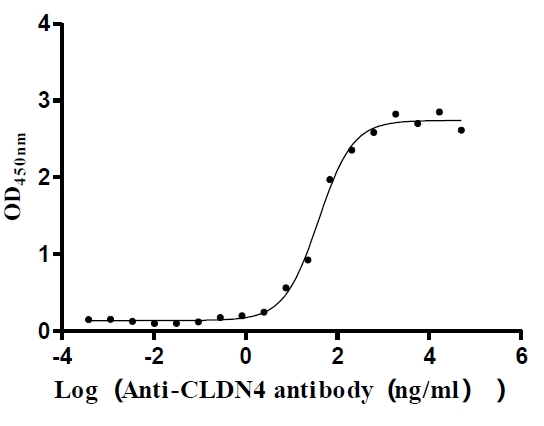
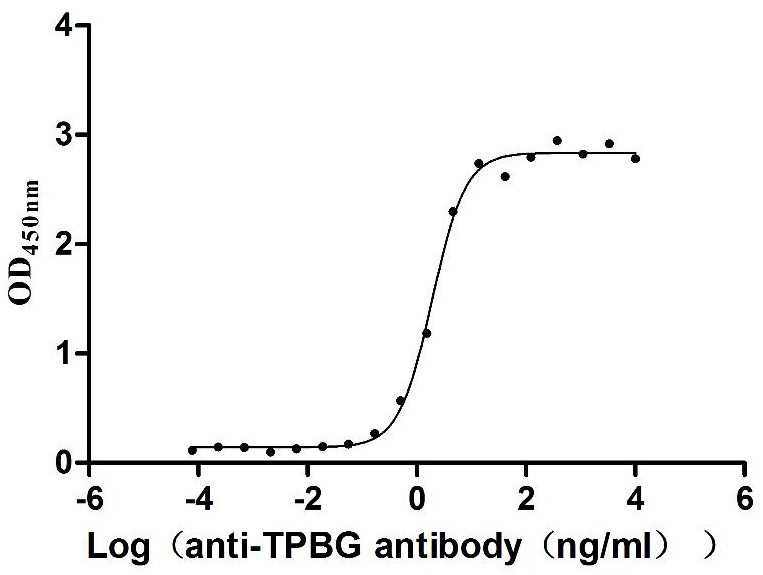
f4-AC1.jpg)
